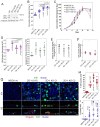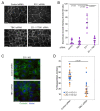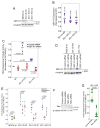ZO-1 Regulates Hippo-Independent YAP Activity and Cell Proliferation via a GEF-H1- and TBK1-Regulated Signalling Network
- PMID: 38607079
- PMCID: PMC11011562
- DOI: 10.3390/cells13070640
ZO-1 Regulates Hippo-Independent YAP Activity and Cell Proliferation via a GEF-H1- and TBK1-Regulated Signalling Network
Abstract
Tight junctions are a barrier-forming cell-cell adhesion complex and have been proposed to regulate cell proliferation. However, the underlying mechanisms are not well understood. Here, we used cells deficient in the junction scaffold ZO-1 alone or together with its paralog ZO-2, which disrupts the junctional barrier. We found that ZO-1 knockout increased cell proliferation, induced loss of cell density-dependent proliferation control, and promoted apoptosis and necrosis. These phenotypes were enhanced by double ZO-1/ZO-2 knockout. Increased proliferation was dependent on two transcriptional regulators: YAP and ZONAB. ZO-1 knockout stimulated YAP nuclear translocation and activity without changes in Hippo-dependent phosphorylation. Knockout promoted TANK-binding kinase 1 (TBK1) activation and increased expression of the RhoA activator GEF-H1. Knockdown of ZO-3, another paralog interacting with ZO1, was sufficient to induce GEF-H1 expression and YAP activity. GEF-H1, TBK1, and mechanotransduction at focal adhesions were found to cooperate to activate YAP/TEAD in ZO-1-deficient cells. Thus, ZO-1 controled cell proliferation and Hippo-independent YAP activity by activating a GEF-H1- and TBK1-regulated mechanosensitive signalling network.
Keywords: GEF-H1; TBK1; YAP; ZO-3; ZONAB; cytoskeleton; focal adhesions; myosin; tight junctions; transcription.
Conflict of interest statement
The authors declare no conflicts of interest.
Figures








References
Publication types
MeSH terms
Substances
Grants and funding
LinkOut - more resources
Full Text Sources
Miscellaneous

